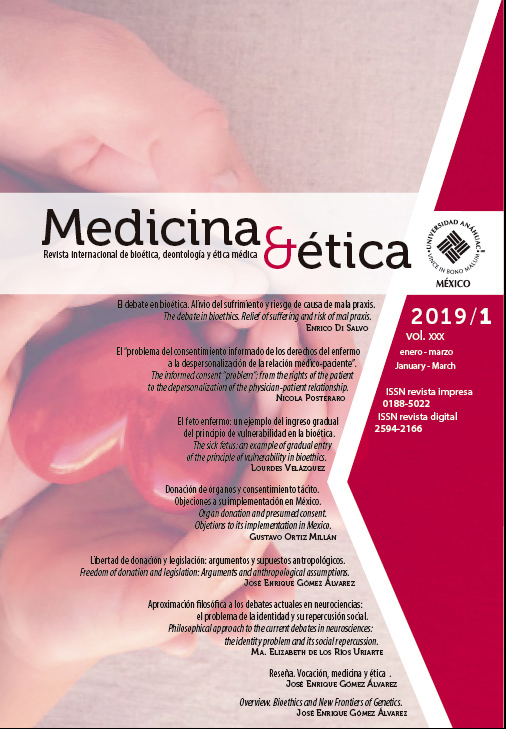The sick fetus: an example of gradual entry of the principle of vulnerability in bioethics
Main Article Content
Abstract
The “principle of vulnerability” is among the most important novelties recently introduced in bioethics, strongly stressed in the “Barcelona Declaration”. According to this principle, the condition of vulnerability of a certain entity entails the moral duty of giving it protection. The aim of this paper is that of showing how this principle has gradually entered bioethics, and also of studying a concrete example, that is, the care of the sick fetus and of the terminal newborn child. On one hand, the care for the sick fetus can be seen as a protection of a vulnerable being but, on the other hand, this fragility does not seem sufficient for justifying a protection for something that cannot have a benefit from it. This because not everything that is vulnerable or fragile deserves protection. The ethical and legal duty of protections comes from the fact that the fragile entity has an intrinsic value. In the case of the incurable fetus this value consists in its being a human person, and also when it is a terminal newborn this condition remains intact, since in all cases this is a human “person” endowed as such with an intrinsic “dignity”. The same discourse applies to the care that must beoffered to the parents of the baby: they are a different class of vulnerable persons with whom we feel a human solidarity.
Downloads
Article Details
Medicina y Ética is distributed under a Creative Commons License Atribución-NoComercial-CompartirIgual 4.0 Internacional.
The author keeps the property rights with no restriction whatsoever and guarantees the magazine the right to be the first publication of the work. The author is free to deposit the published version in any other medium, such as an institutional archive or on his own website.
References
Theoretical Medicine and Bioethics. Theoretical Medicine and Bioethics, 23 (6),
421-424.
El feto enfermo: un ejemplo del ingreso gradual del principio de vulnerabilidad
Medicina y Ética 2019/1 105
2 DE BRUIN, D. (2001). Reflections on ‘Vulnerability’. Bioethics Examiner, 5 (2):
1, 4, 7.
3 FLANIGAN, R. (2000). Vulnerability and the Bioethics Movement. Bioethics Examiner,
16 (2), 13-18.
4 HURST, S.A. (2008). Vulnerability in Research and Health Care; Describing the
Elephant in the Room? Bioethics Examiner, 22 (4): 191-200.
5 KOTTOW, M.H. (2004). Vulnerability: What kind of principle is it? Medicine, Health
Care and Philosophy. 7, 281-287.
6 (2003). The vulnerable and the susceptible. Bioethics, 7/5-6, 460-471.
7 LEVINE, C. (2004). The Limitations of «Vulnerability» as a Protection for Human
Research Participants. American Journal of Bioethics, 4/3, 44-49.
8 MACKLIN, R. (2003). Bioethics, vulnerability, and protection. Bioethics, 17. 472-
486
9 MIRANDA, G. (2011). Come nacque il “principio di vulnerabilità”. Studia Bioetica,
4/2: 5-7.
10 MORAWA, A.H.E. (2003). Vulnerability as a Concept in International Human
Rights Law, Journal of International Relations and Development, 6/2, 139-155.
11 RENDTORFF, J.D. & KEMP, P. (Eds.) (2000). Basic Ethical Principles in European
Bioethics and Biolaw. Copenhagen y Barcelona: Centre for Ethicsand Law & Instituto
Borja de Bioètica.
12 RUOF, M.C. (2004). Vulnerability, Vulnerable Populations, and Policy. Kennedy
Inst Ethics Journal, 1474, 411-425.
13 SOLBAKK, J.H. (2011). The principle of respect for human vulnerability and global
bioethics. En CHADWICK, R., TEN HAVE, H. & MESLIN, E. (Eds.). Health Care Ethics
in an Era of Globalization, PAÍS: SAGE Publ.
14 THAM, J., GARCÍA, A., MIRANDA, G. (2014) Religious Prespectives on Human
Vulnerability in Bioethics, Ed. Springer.
15 UNESCO (2005). Universal Declaration on Bioethics and Human Rights.
Recuperadode:http://portal.unesco.org/shs/en/ev.phpURL_ID=1883&URL_
DO=DO_TOPIC&URL_SECTION=201.html
16 VELÁZQUEZ, L. (2017). El tratamiento del neonato terminal desde el punto de
vista bioético. EUNSA.

